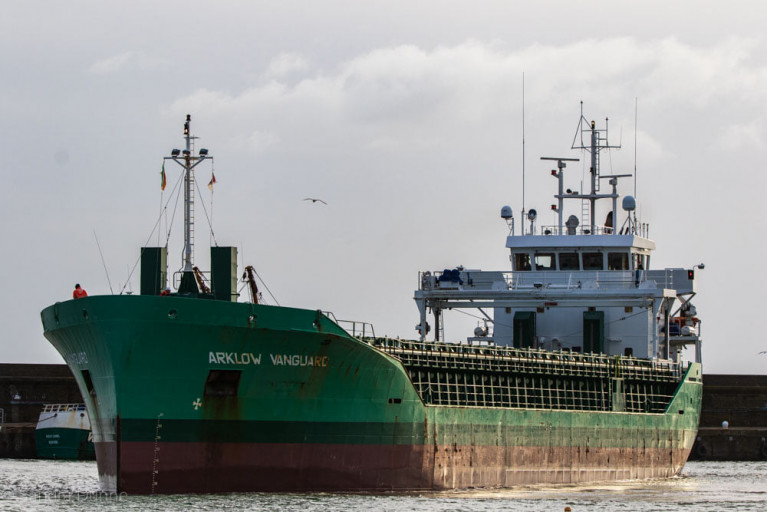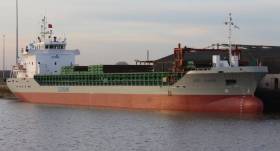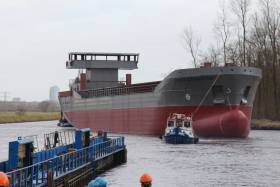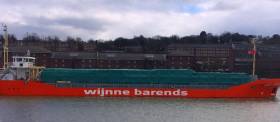Displaying items by tag: Wicklow Port
Before signing off for Afloat's report on RV Celtic Voyager's Dun Laoghaire call and bad weather forecast for Wicklow Head, this led to tracking an Arklow Shipping cargoship on a rare call bound to the nearby port, writes Jehan Ashmore.
The Arklow Vanguard had anchored overnight off Wicklow Head having sailed across the Celtic Sea from Avonmouth Docks (see: story), one of the two Bristol Port Co. ports. The other is Royal Portbury Docks on the opposite bank of the River Avon.
This morning the Royal Bodewes built Arklow Vanguard (2017/2,999grt) berthed alongside the Packet Quay, where the berth is the most used by commercial shipping in Wicklow Port. The cargoship was in ballast to load recyclable metals.
Arklow Vanguard's 'maiden' call to the east coast Irish Port is the first Arklow Shipping cargoship in almost a decade to Wicklow when Afloat reported on previous coaster's call to load scrap metal.
On that occasion in June, 2011, the Irish flagged Arklow Rebel (exactly same tonnage) of today's 'V' class though at 86.93m long is slightly shorter compared to the 'R' class (89.99m) dating to 2005.
Arklow Vanguard is the first to carry this name for ASL, albeit this particular cargoship is managed by their Dutch arm, Arklow Shipping Nederland B.V.
Among other vessels in port are AMS Retreiver and Husky, both belonging to Wicklow based Alphamarine and otherwise previously known as Island Shipping.
Take A Walk Along Wicklow Port's East Pier With 'Waverley' On Your Side
#PaddleSteamer - In recent weeks, Waverley, the World's last sea-going paddle steamer, which has visited Irish ports among them Wicklow, returned to its Scottish homeport for winter layover following a UK season of coastal exursions, writes Jehan Ashmore.
Waverley's wake has included the waters off the Antrim coast, having set off from Scotland, where the 623 tonnes vessel is currently berthed on the Clyde just downriver of Glasgow City. The Waverley is berthed on the banks of where famous shipyards stood and nearby of the present day Riverside Museum of Transport featuring tallship Glenlee. The barque is the UK’s only remaining floating Clyde-built cargo sailing ship dating to 1896 and during its clipper ocean trading career called to Cobh.
The visits to Wicklow by Waverley is represented by a wonderfully executed mural painted on the East Pier by local marine artist Pat Davis. Recently, a new mural of the Irish Naval Service coastal patrol vessesl (CPV) LÉ Orla was added. This brings to 40 murals in total by Davis, including brigantine Asgard II that sank a decade ago. They line the length of the breakwater bookended by the Wicklow Sailing Club and the pierhead lighthouse.
Incidentally, CPV LÉ Orla was launched as HMS Swift in Scotland for the Royal Navy's 'Peacock' class. Under INS career (30 years), the small patrol vessel has never called to the port, though many years before, LÉ Gráinne another former RN 'Ton' class patrol vessel did and is depicted in a mural at the beginning of the pier.
It was at Wicklow Port's pier, where P.S. Waverley called to the Irish east coast port in 2001, a trip recalled with much fondness, having embarked in Dublin Port, from there the power of those paddles propelled the veteran vessel also to Arklow and as far south offshore of Courtown Harbour, Wexford.
Another, previously enjoyed coastal paddlesteamer excursion in 1984 involved the short hop across Dublin Bay from the capital to Dun Laoghaire Harbour. Also in that year, transits through Dalkey Sound made for a spectacular sight (see photo p. 37 'Maritime' Dalkey) as the vessel swept up and down along the coast. Other ports during this rare calls over the years have included Dundalk and Rosslare Harbour.
The 73m long paddle-steamer with capacity for 925 passengers, arrived last month on the River Clyde from where the keel was laid in 1945 at the former A&J Inglis Ltd shipyard in Glasgow. Due to material shortages after the war, the steamer was not ready for launch until October 2, 1946, however it was not till the following year that the vessel was towed to Greenock where boiler and engines were installed.
Waverley, finally made a maiden voyage on June 16, 1947 that began a very long career iniatially for London & North Eastern Railway. In the following year due to Nationalisation of Railways the paddle steamer became part of the Caledonian Steam Packet Company to serve duties on the Clyde. The distinctive angled twin funnels could be seen serving Scottish waters until retirement in 1973. The paddle steamer was saved the next year when gifted to the Paddle Steamer Preservation Society (PSPS) for a nominal £1.
The Waverley decades later remains magnificently restored with those towering funnels, varnished timber decks and gleaming brass fittings. On board, excursionists on the steamer operated by Waverley Excursions, can hear but also observe directly the mighty steam engines as they propel the paddles through the sea.
Next year the PSPS will celebrate a Diamond Jubilee, having been founded in 1959 when many paddle steamers were been withdrawn from within UK coastal waters. Waverley Excursions are in the process of planning the 2019 season with a programme operated on behalf of owners the Waverley Steam Navigation Company.
Volunteers Wanted...
In the meantime during the Waverley's winter layover in Glasgow, skilled tradespeople are been sought to carry out maintenance on board. So if you are an engineer, electrician, plumber or joiner you can submit the volunteering form to email: [email protected] and for further information by clicking this link
'Sammy the Seal' Steals the Show With Ship-Side Survelliance
#CoastalNotes - During Afloat's visit to Wicklow Port this day last week, seemingly Sammy the Seal made a fleeting appearance when alongside a departing cargoship, writes Jehan Ashmore.
The departure that afternoon of Burhou-I involved the curious 'Sammy' or a fellow companion? make for inspection as the cargohip eased off slowly from the Packet Quay. On the next attempt to take a further zoomed-in photo, the seal slipped underneath the calm waters within Wicklow harbour.
Sammy the Seal has became something of a local celebrity in the town and beyond having gone 'viral' in recent years when footage showed the hungry grey seal 'visiting' the local fishmonger.
The presence of Sammy however, has become something of a nuisance, if you ask the staff of fishmongers, The Fishman on South Quay where local trawlers land catch. The fishmongers have to keep an eye on the mammal when crossing what can be a busy road before throwing him tasty fish scraps meals – one of three every day at high tide.
Returning to the port's commercial shipping activities, Burhou-I is engaged in the timber trade. The 674grt coaster is operated by Great Glen Shipping Co, Scotland from where round timber (logs) had been loaded for discharge in Wicklow Port.
Also in port this day last week was the cargoship's sister, Isis which this afternoon is bound for Wicklow Port having sailing from western Scotland. On board is more round timber having been loaded in Sandbanks, Holy Loch, located on part of the Cowal Peninsula along the Firth of Clyde.
Timber Trader Trio Clear Back-Log in Scotland With Cargoes Discharged in Wicklow Port
#Ports&Shipping - It was busy in Wicklow Port following the St. Patrick's Holiday Monday as a trio of timber traders arrived yesterday to dicharge cargoes and then depart within the same day, writes Jehan Ashmore.
Round timber (i.e. logs) which is a common trade to Wicklow Port and used for the contruction industry, however encountered delays when loading at Scottish ports according to Conway Port. The Wicklow based ships agency, warehouse and distribution company, added the back-log at Scottish west coast ports was caused by snow and windy conditions. Such severe weather has battered most of Europe coupled by this latest spate of wintry weather.
Of the trio of timber-trading cargoships that docked in Wicklow, two were sisters. Burhou I was first to arrive yesterday morning laden with the forest-product loaded in Port Ellen, Islay in the Hebrides. The cargoship on arrival in Wicklow (see related story) docked at the principle Packet Quay berth.
Sister, Isis (see Afloat's report from Ramsey, Isle of Man) had loaded but on the Scottish mainland at Sandbanks, Holy Loch on the Firth of Clyde. From there, Isis made a lunchtime arrival in Wicklow, this involved berthing beyond Burhou I at the North Quay, facing opposite of the town.
Burhou I and Isis, represent an older generation of coaster, as this year the German built veterans are 40 years in service. Both of the 674grt sisters are operated by Great Glen Shipping Company Limited based at their homeport of Corpach, Fort William close to Ben Nevis.
At 57m long and on a beam of 10m, the 'Glen' sisters are ideally placed to service small piers and harbours that suits the ethos of the Scottish operator. This is to provide vital logistical links to the Highlands and Islands and a core focus in removing lorry traffic from the region's road network.
In addition, the pair are easily suited to Wicklow Port and when required berthing within the relative confines of the River Vartry at the North Quay. This is when berthing at times coincides with the local fishing fleet that raft-up opposite along the South Quay.
The third timber caller to Wicklow was Ayress (1,713grt) having sailed also from the Clyde, but from Troon and which made an arrival to Wicklow Port but not until late afternoon. Discharging of round-timber shortly began operations using the port's Liebherr crane. This larger short-sea trader, at 79m long and a beam of 12.8m, had taken the berth from where Burhou I previously occupied before the coaster returned to the Clyde but to Ayr.
As for the aforementioned Ayress, this cargoship again dates to the same decade as of the rival 'Glen' pair, having been completed in 1979. The cargoship operated by Coast Lines Ltd, based in Midleton, Co. Cork, is a short-sea trader flagged in Dominica. The company asides trading in timber are also engaged in transporting coal, fertiliser, salt and stone.
Conway Port added that business in Wicklow is marginally on the increase compared to 2017 and this year they have 150 ships scheduled. Of those, Jevenau was also expected to arrive yesterday, however the 89m cargoship arrived from Greenore, Co. Louth this morning. On this occasion the cargo concerned was recycled metals, though the port can also handle packaged timber, glass, aggregates, agri-products in addition to project cargoes.
Two years ago, Wicklow became the first port to transfer from a port company under the National Ports Policy. Prior to the Wicklow Port Company, the entity up until 2002 had been in the hands of Wicklow Harbour Commissioners. The docking of three ships in one day is not unusual for the regional port.
As for this year, on June 30 to be precise, sees the return of the famous Volvo Round Ireland Yacht Race organised by Wicklow Sailing Club. The premises of the WSC is located at the foot of the port's East Pier.
Forest Products Operator Orders Another Newbuild from Dutch Yard
#Ports&Shipping - Scotline which chiefly operates in Scandinavian forest products imports among those to Ireland, have announced the signing of a contract with a Dutch shipyard to build a 4,785dwt Bodewes trader.
The description of the newbuild refers to the yard of Royal Bodewes Group BV whose in-house design to build the short-sea trader comes with an option of a second vessel. The Scot Carrier is being built by the same yard as – and will be similar to – the Scot Leader which is a caller to Wicklow Port through local ship agency Conway Port.
Afloat adds among Scotline's network of liner services, the sailing schedule to Wicklow from Varberg, Sweden also includes calls to Belfast and Warrenpoint.
Scot Carrier and will have a length of 89.98 meters, a beam of 15.20 meter and a maximum sailing draft of 5.68 meters. She will be powered by a MAK engine and will sail under the UK flagand classed under Lloyds Register.
The hull is expected to be launched in September 2018 and we expect the finished vessel to be delivered in November 2018. She will be fully container fitted, with Swedish ice class 1B and will be built to comply with all the latest legislation including provisions to be ready for the Ballast Water Treatment regulations.
The Scot Carrier will be the most recent acquisition to Scotline’s fleet of 8 owned vessels. As also previously reported on Afloat, Scot Navigator was delivered last year as the start of our efforts to renew some of our older tonnage.
Scotline runs a fleet of coasters serving northern Europe with regular routes between Sweden, Ireland, Denmark, Germany, Norway, the Baltic States, the Netherlands, France and the UK. In addition to forest products, the operator handles bulk cargoes to project cargoes and many others.
With terminals in Rochester, England and Inverness, Scotland the operators fleet offer customers an all-in-one service of shipping, stockholding and distribution. The company also fixes market cargos for their vessels through use of the operators network of contacts worldwide.
#Redwater – ‘Redwater’ the BBC Studios in association with RTE produced drama spin-off of Eastenders, mostly shot in Dunmore East, Waterford, is home to a fishing fleet and likewise of Wicklow Port, writes Jehan Ashmore.
The east-coast port of Wicklow is where this morning is docked the distinctive red-hulled cargoship, Ceg Cosmos (1983/1,139gt). Only last night the small sixty metre long ship which is a regular to the port had sailed from Scotland loaded with felled trees. In the trade, such cargo is referred as ‘round’ timber.
This is a major trade for Wicklow Port that also imports packaged sawn timber for the housing / construction industry. On a related note the farmhouse featured in ‘Redwater’, used an inland location from Wicklow, where the River Vartry flows through the port and that is close to Roundwood, one of the highest villages in Ireland. The village at an altitude of 238m (781ft) above sea level is a gateway to the Wicklow Mountains.
To the east of Roundwood is where the Vartry fed-reservoir, a feat of Victorian engineering featured in the Bradshaw guide led BBC series of Micheal Portillo’s ‘Great Railways Journeys’ on Irish Railways. Among the railway lines included in this recent return of the series to Ireland was the Wexford (Rosslare Europort)-Dublin service. On this line a railway bridge crosses the Vartry that follows into the Broadlough Estuary. This borders The Murrough, north of Wicklow Port to where timber storage warehouses are located.
The river continues through Wicklow Port to finally enter the Irish Sea. Just two miles south of the town, the crew and cast of Redwater also filmed beach scenes at Magheramore Strand.
The Ceg Cosmos flies the UK Red Ensign or Red ‘Duster’ as it also known and which is the case of Wicklow where the cargoship normally trades from Scottish ports of Corpach, Holylock and Sandbank. The latter port been the previous call. Also berthed in Wicklow today at the East Pier is the gaff-rigged Maybe that sailed from Belfast.
'Working' the Wicklow Way
In recent weeks Ceg Cosmos, however had crossed the Irish Sea but from the English north-west port of Workington. The above photo shows the Gibraltar registered Ceg Cosmos in Wicklow having called from the Cumbrian port.
Asides commercial shipping the Irish port as mentioned has a fishing fleet, and also seen are empty fish boxes stacked high on the South Quay. Most of the fleet are small inshore craft, though on occasion larger beam-trawlers make an appearance. An example, Briget Carmel which featured in one of 'The Angelus' slots broadcast on RTE.
Upon closer examination of these fish boxes, Afloat has identified a firm based in Waterford where the fictitious town of ‘Redwater’ is alas the scenic village of Dunmore East. In addition the boxes included those from fishing co-ops stretching from Castletownbere in west Cork to as far north to Lough Foyle, Donegal.
One box that clearly stood out was a Dorset fish company based in Poole. Also a ferryport located on the English south coast.
Detained Dutch Flagged Cargoship Tied Up In Wicklow Port
#Detained - A Dutch flagged general cargoship that was due to Dublin Port last night remains under detention in Wicklow Port having discharged packaged timber, writes Jehan Ashmore.
Irish maritime authorities detained the 2010 built Crown Mary on behalf of the Paris MoU in which Ireland is a member of the organisation. The mission of the Paris MoU is to eliminate the operation of sub-standard ships through a harmonized system of Port State Control. A list of ships that are currently under detention in the Paris MoU region can be consulted here.
The 2,622 gross tonnage Crown Mary had sailed from New Holland, located on the Humber Estuary opposite Hull, a major North Sea ferryport. Just over a year ago Afloat previously reported of another detained cargoship Burhou I in Wicklow. Again this albeit smaller cargoship was employed in the timber trade.
The Paris MoU (Memorandum of Understanding) on Port State Control (PSC) was signed in January 1982 by fourteen European countries at a Ministerial Conference held in Paris, France. It entered into operation on 1 July 1982. The principles of the MoU also cover the following:
Safety of life at sea
Prevention of pollution by ships, and
Living and working conditions on board ships
The Paris MoU on PSC is an administrative agreement between 27 Maritime Authorities. The participating maritime Administrations of the Paris MoU covers the waters of the European coastal States and the North Atlantic basin from North America to Europe.
Since the detention was imposed last Saturday, Afloat had noted the 88m Crown Mary shift berths within Wicklow Port. This involved the vessel vacate the main commercial Packet Quay to the East Pier so to enable other cargoships to dock. So far two ships have called, Thea Marieke also Dutch flagged arrived from Sheerness, Kent. Last night the vessel docked in Dublin and this morning Scot Pioneer called to Wicklow having sailed overnight from Warrenpoint.
Only the day before the detention, Wicklow recieved the first call of the newly renamed car ferry Fraser Aisling Gabrielle. The 44-car capacity ferry made an overnight stop while en route from Waterford to Greenore from where next month a new Carlingford Lough service is to operate to Greencastle.
Update May 24 2017: Detention of Dutch Flagged Cargoship In Wicklow Port Is Lifted
New Navigator to Trade Timber On Short-Sea Services
#Newbuild - Scot Line a trader of packaged timber on the Irish Sea have added a 88 metre long newbuild to its fleet that operates an Ireland-UK-Scandinavia liner service, writes Jehan Ashmore.
The newbuild Scot Navigator will become the 10th vessel of the fleet in which such ships are regulars to Irish east coast ports, Dublin and 35 miles to the south Wicklow. The port became the first of five Regional Ports of Significance having been transferred to local authority control under the 2013 National Ports Policy.
Imports of packaged timber are for the construction industry, a 'bread and butter' cargo trade for Wicklow Port. A role potentially involving Scot Navigator which was launched last month in the Dutch yard of GS Yard B.V. in Groningen. Delivery and operational service is scheduled for May.
The modern efficient design of Scot Navigator makes for an ideal addition to the operators expanding fleet, being built with a timber-fitted capacity of about 5,500 cubic metres. The newbuild also complies with all the latest legislation including provisions for ballast water treatment.
Scot Navigator will be powered by a Caterpillar engine. The new ship is to sail under the UK flag like the rest of the fleet among them Scot Leader which was acquired in recent months. This cargoship is also of similar length but with a larger timber-fitted capacity of 6,325 cubic metres.
Scotline Take Time-Charter of Dutch Short-Sea Ship Trading to Ireland
#Scotline – Scotline the short-sea timber products operator recently took a time-charter of Lady Ariane which berthed in Wicklow Port today, writes Jehan Ashmore.
The box shaped singledecker had sailed from the Swedish port of Varberg. The Scandinavian port that firmly established Scotline as an operator from the late 1970’s in the transportation of forest-product cargo of logs from Inverness.
In the present day, the company are responsible for transporting a high percentage of all softwood (packaged timber) into the UK through operating liner services. This includes operations to Ireland.
The time charter of Lady Ariane is from Dutch short-sea operator, Wijnne Barends. Also added to the fleet is Scot Leader which was recently acquired and brings the fleet total to 12 vessels.
In regards to Wijnne Barends they are based in Delfzijl. The North Sea port is where the asphalt/bitumen tanker Iver Ability is bound to.
The red-hulled ship anchored in Dublin drew much public attention following months spent offshore following a ‘reaction’ during transport of bitumen in Dublin Port last summer.
Iver Ability was monitored yesterday by Afloat while transiting the Strait of Dover. At it’s narrowest point the distance of the Strait is a mere 33.3 kilometres (20.7 miles).
On a daily basis there is around 400 vessels transiting through the Strait, the world’s busiest channel. Asides ships of many types there are ferries criss-crossing between the Port of Dover (see record freight) and the French ports of Calais and Dunkerque.
This afternoon the tanker is at anchorage of the West Frisian Islands. The archipelago lies off the approaches to the Ems Estuary that leads to Delfzijl.
Ship Snapshot: Cargoship Scrap-Trades On the Irish Sea
#ShipSnapshot – Lady Adriane berthed at Wicklow Port this morning in the wake of another short-sea trader, the 89m Bounder which at the weekend was loaded with scrap metal, writes Jehan Ashmore.
It was a busy scene as trucks shuttled between the Bounder and a nearby recycling plant. A Liebherr crane was employed to grab the scrap and lower into the hold.
Also on the Packet Pier were logs (round timber) stacked high and awaiting removal. This cargo had been discharged from Ceg Cosmos, a smaller ship that called last week on a typical passage from Scotland.
Both these cargoes were handled through local shipping agent, R.F Conway & Co. (Conway Port) which among trades also handles timber products, notably through Scotline. The shipping company have recently taken on a time charter of Lady Adriane. Afloat will have more on this to report.
On completion of loading the scrap metal, Bounder departed Wicklow on Sunday.
The 3,223dwt vessel arrived yesterday at Liverpool, where the scrap-metal was to be discharged in Alexandra Dock Branch No.2.

































































